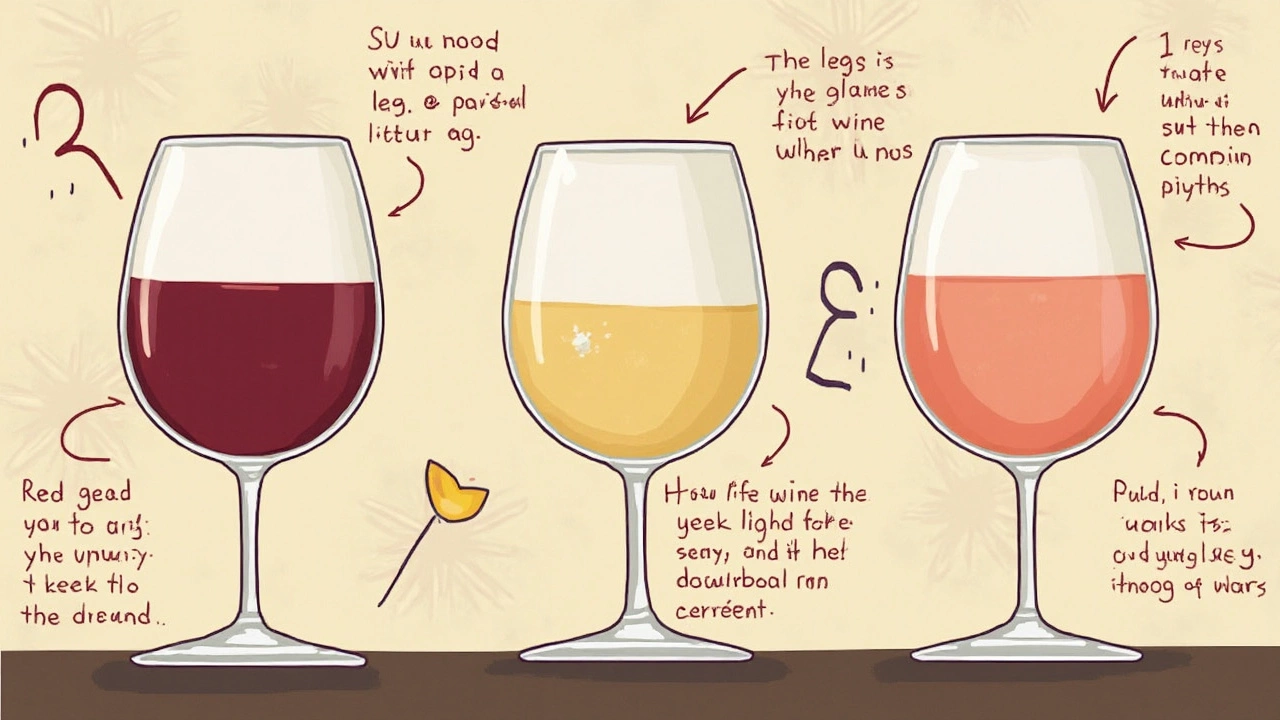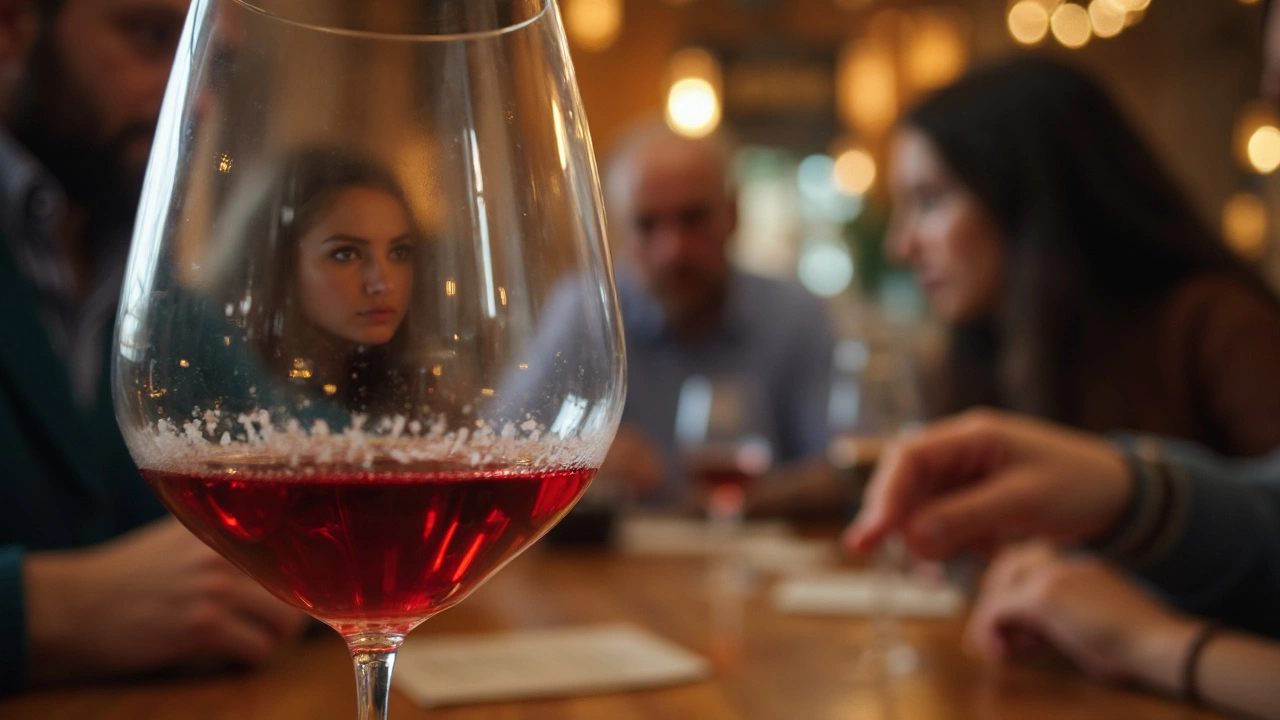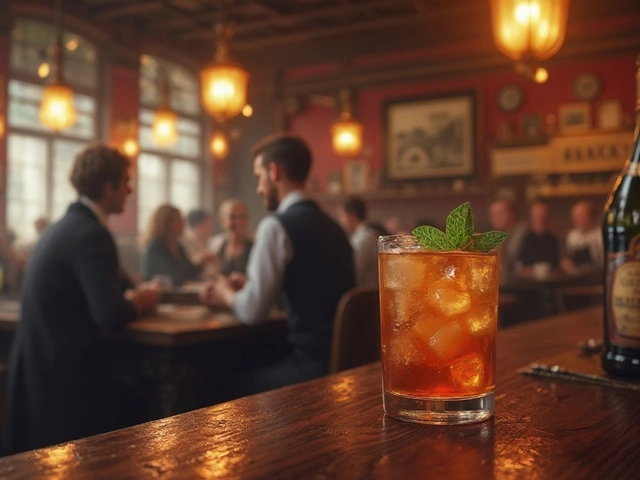Ever sat with a glass of red in hand and noticed those clear streaks slowly crawling back into the wine? People call them legs, tears, or even church windows. Sounds fancy, but the reality is way more simple—and honestly, a bit less dramatic than some folks make it out to be.
So, what do legs actually mean? Here’s the no-nonsense answer: they’re mostly about alcohol and evaporation, not about price or quality. Watching legs form and slide down the glass isn’t some secret handshake for wine snobs; it’s really just science in action. If you’ve ever heard someone at a party claim that long, slow legs mean expensive, high-quality wine, they’re just telling a good story. Grab your glass, tilt it a bit, and pay attention—not because you’ll unlock the mysteries of the vineyard, but because it’s kind of cool to know what’s actually happening. If you’re into wine tasting or just curious about what’s swirling in your glass, understanding legs puts you a step ahead of most folks at the table.
- What's Up With Wine Legs?
- Why Do They Happen?
- Legs and Alcohol: The Real Connection
- Do Legs Mean Quality?
- How to Use Legs in Wine Tasting (Or Not)
What's Up With Wine Legs?
Wine legs are those streaks or droplets running down the inside of your glass after you swirl it. Maybe you've heard someone talk them up at a tasting or seen a sommelier give your glass an extra spin. Here's the deal: wine legs are just a visual reaction that happens when alcohol and water in the wine evaporate at different speeds. Nothing mystical. And they’re not limited to reds—white and rosé wines can show legs, too.
These legs form when you swirl your wine. The thin film of wine that goes up the side of the glass starts to drip back down. Alcohol evaporates faster than water, and that's what causes those droplets to form and slide. This effect has a real name, too: the "Marangoni effect"—named after an Italian scientist who studied liquids and their behaviors. No need to memorize that for your next wine night, but it's cool to know.
Plenty of folks think wine legs reveal something deep about the wine, like its price or whether it’s a hidden treasure. Truth is, legs mostly hint at alcohol content and, sometimes, a bit about sugar if the wine’s on the sweeter side. Your average table wine has enough alcohol for legs to show up, so don't be surprised if even a budget bottle puts on a show.
If you’re curious, here’s a side-by-side of what influences legs in a wine glass:
| Factor | Impact on Wine Legs |
|---|---|
| Alcohol Content | More alcohol usually means more pronounced legs |
| Sugar | Sweeter wines can cause thicker, slower legs |
| Temperature | Warmer wine may show legs faster as alcohol evaporates quickly |
| Glass Shape | Taller, narrower glasses exaggerate the effect |
So next time you see those wine legs, you’ll know it’s less about bragging rights and more about simple science. They’re fun to watch—just don’t read too much into them.
Why Do They Happen?
Here's where the science kicks in—wine legs form because of a thing called the "Marangoni effect." Basically, it’s all about how alcohol and water in the wine evaporate at different rates. Alcohol evaporates faster than water, and when it does, it leaves behind more water (with a bit of dissolved stuff like sugars) sticking to the glass. Gravity then pulls this liquid down and you get those streaky lines, or wine legs.
To put it super simply: swirl the wine, the liquid goes up the glass, alcohol evaporates especially fast near the top, and the leftover water forms droplets that run down. That’s it. And it happens every time you swirl any wine with enough alcohol in it—doesn’t matter if it’s red, white, or rosé.
Want to see something cool? Try comparing wines with different alcohol content. You’ll notice that wines with higher alcohol tend to make thicker and slower legs. The whole thing comes down to a simple physical reaction, not any secret info about the wine’s price tag or age.
- Warm weather or crowded rooms speed up evaporation, so legs can show up even quicker.
- Residual sugar and glycerol (which is just a natural byproduct of fermentation) can make the legs look thicker, but alcohol is the main star.
- Swirl hard or gentle—it’s all about getting the wine to climb up the glass so you see the legs in the first place.
Here’s a little comparison so you can spot the difference. This isn’t magic; it’s just chemistry doing its thing.
| Wine Type | Alcohol Content (%) | Typical Legs |
|---|---|---|
| Light White | 10-12% | Thin, quick legs |
| Full-bodied Red | 13-15% | Thicker, slower legs |
| Fortified Wine (Port) | 18-20% | Very thick, long legs |
Bottom line: If you see legs, you’re just watching alcohol and water duke it out right in your glass.

Legs and Alcohol: The Real Connection
Here’s where things get interesting. The wine legs you see aren’t random—they’re tied directly to how much alcohol is swirling around in your glass. This isn’t just a theory; it’s solid science, and it’s called the Gibbs-Marangoni effect. When you swirl your wine, a thin film climbs up the side of your glass. That layer starts to evaporate, and since alcohol evaporates faster than water, it leaves some water (and sugar if it’s a sweet wine) behind. Gravity takes over, and that leftover liquid slides back down as legs or tears.
If you’ve got a wine with high alcohol content—say, 14% or more—you’ll usually see more legs and they’ll move slower. Wines with less alcohol, like some whites or rosés around 10-11%, show less dramatic legs. It’s a direct, visible clue about what you’re sipping, and it works with both reds and whites—it’s not just a red wine thing.
| Wine Type | Typical Alcohol (%) | Legs Visible? |
|---|---|---|
| Cabernet Sauvignon | 13.5-15 | Yes (distinct, slow legs) |
| Chardonnay | 12-14 | Yes (moderate legs) |
| Riesling | 8-11 | Few or subtle |
But don’t get tricked—while wine legs show how much alcohol’s in your glass, they don’t say a thing about taste or quality. You’ll see more legs after swirling a strong Port than a crisp Pinot Grigio, but that’s just about booze, not bragging rights.
One quick tip: check out the legs if you want a hint at how strong a wine feels. It’s a visual cue, not gospel, but it can be handy if you’re picking something for the night and want to avoid a wine hangover in the morning.
Do Legs Mean Quality?
This is one of the most common wine myths out there. You spot dramatic wine legs on the side of your glass and someone says, "Wow, this must be a fancy bottle." In reality, those legs have nothing to do with wine quality. They're just the result of the alcohol and water in your wine reacting to the air and the glass itself.
Back in the 19th century, scientists even identified what causes legs—the Gibbs-Marangoni effect. When you swirl your wine, alcohol evaporates faster than water, making the liquid climb up the glass. Gravity pulls it down again, leaving those trails behind. It’s pure physics, not a sign of expensive grapes.
Don’t just take my word for it. Here’s what Madeline Puckette from Wine Folly says:
"Legs or ‘tears’ on a wine are linked to alcohol content, not quality. Big legs just mean your wine has more alcohol or maybe sugar—nothing more."
If you actually want to scope out the quality of a wine, try these steps instead:
- Check the aroma—swirl the glass and smell. Good wine has layered, pleasant scents, not just alcohol.
- Look at the color—brighter colors often mean fresher wine.
- Taste for balance—do the flavors, acidity, and tannins feel smooth and even?
- Notice the finish—a quality wine lingers on your taste buds.
Another fun fact from a 2023 survey: 67% of casual wine drinkers thought wine legs showed better wine. But in blind tastings, those legs had zero impact on how experts rated the wine. So, sure, notice the legs, but don’t let them pick your bottle.

How to Use Legs in Wine Tasting (Or Not)
So, you’ve got your wine swirl down and you’re watching those wine legs trickle down the glass. What next? First, don’t stress—legs aren’t some top-secret quality code. Still, they can give you a quick hint about your wine’s alcohol content and sweetness.
Here’s what’s actually helpful when checking out wine legs during tasting:
- If the legs move slowly and hang onto the glass, your wine probably has a higher alcohol content or more sugar. Wines like port or zinfandel will often have thicker, slower legs compared to a pinot grigio.
- Fast, thin legs usually mean lower alcohol—think of lighter white wines and some rosés. They typically don’t have the same syrupy look.
- Don’t use legs to judge wine quality. There’s no real link. Some of the cheapest wines have pronounced legs just because they pack more booze, not better flavors.
- Legs can tell you if a wine might feel heavier in your mouth. More alcohol and sugar means a fuller, rounder feel, which is handy for figuring out what you’ll actually like.
Still unsure? Here’s a quick table showing examples of different wine legs and what they can mean:
| Wine Type | Legs Look Like | Likely Meaning |
|---|---|---|
| CABERNET SAUVIGNON | Slow, thick legs | High alcohol, fuller body |
| RIESLING | Fast, thin legs | Low alcohol, lighter body |
| PORT | Very slow, sticky legs | High alcohol, lots of sugar |
Long story short, watch the wine legs if you’re curious about the strength or sweetness, but don’t fall for the myth that they’re a shortcut to knowing what’s good. You’ll learn way more about your wine by smelling and tasting it than staring at glass streaks. If you like the look, enjoy the show—but don’t let it call all the shots during your next wine tasting night.


